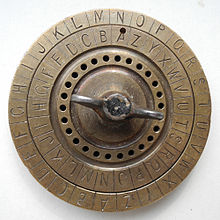Atbash
Atbash (also atbash , Hebrew אתבש) is a simple method based on the Hebrew alphabet for encrypting or decrypting a text. The originally Kabbalistic method also served to reveal a meaning that was believed to be hidden in religious texts.
The name Atbasch is derived from the first and last two letters of the Hebrew writing system (ATB-Sh) and at the same time illustrates the procedure in which the first letter ( Aleph ) is swapped with the last letter ( Taw ), the second letter ( Beth ) is swapped with the penultimate letter ( Schin ) etc.
The Atbash value denotes the numerical value of the countersign, since Hebrew characters also have a numerical value: Aleph (1) and Taw (400) have the Atbash value 400 and 1 .
properties

Atbasch is one of the simple monoalphabetic substitution methods and is a variant of the Caesar encryption ( reverse or reverse Caesar encryption ).
A special feature is that Atbasch is an involutive process, i.e. the encryption and decryption methods are identical. It is therefore sufficient to apply the Atbasch substitution a second time to the ciphertext to get the original text again.
Since the Atbasch is a fixed procedure and does not allow any key-dependent variations, there was only security through obscurity , which is certainly no longer the case today.
ATBaSch
Principle of the Atbash, applied to the Latin alphabet :
| A. | B. | C. | D. | E. | F. | G | H | I. | J | K | L. | M. | N | O | P | Q | R. | S. | T | U | V | W. | X | Y | Z |
| Z | Y | X | W. | V | U | T | S. | R. | Q | P | O | N | M. | L. | K | J | I. | H | G | F. | E. | D. | C. | B. | A. |
Atbasch of the Hebrew alphabet and its German transcription:
(The name is given by the first two pairs of letters to be swapped: A leph with T aw and B eth with Sch .)
|
A Aleph א |
B Beth ב |
G Gimel ג |
D Daleth ד |
H Hey ה |
W, V, F, O waw ו |
Z Zajin ז |
H Chet ח |
T Tet ט |
I, J, Y iodine י |
K Kaph כ ך |
L Lamed ל |
M mem מ ם |
N Now נ ן |
X Samech ס |
O Ajin ע |
P Pe פ ף |
Z Sade צ ץ |
Q Koph ק |
R Resch ר |
Sch, S Schin ש |
T Taw ת |
|
T Taw ת |
Sch, S Schin ש |
R Resch ר |
Q Koph ק |
Z Sade צ ץ |
P Pe פ ף |
O Ajin ע |
X Samech ס |
N Now נ ן |
M mem מ ם |
L Lamed ל |
K Kaph כ ך |
I, J, Y iodine י |
T Tet ט |
H Chet ח |
Z Zajin ז |
W, V, F, O waw ו |
H Hey ה |
D Daleth ד |
G Gimel ג |
B Beth ב |
A Aleph א |
Example:
- From " Baphomet " (ב פ ו מ ת) "Sophia" (ש ו פ י א) form. This was also known as Cryptologic mystery in the novel The Da Vinci Code ( The Da Vinci Code ) is used.
Variant ALBaM
ALBaM ( Hebrew אלבם) is an encryption method similar to ATBaSch. The Hebrew alphabet, consisting of 22 characters, is divided into two halves of 11 letters each (א-כ and ל-ת) divided, these are directly assigned to each other. This is the same principle that is used in the Latin alphabet as ROT13 . By shifting the characters by half the alphabet width, encryption and decryption are identical.
Scheme of the substitutions:
(Here, too, the name is given by the first two pairs of letters to be swapped: A leph with L amed, B eth with M em.)
|
Aleph א |
Beth ב |
Gimel ג |
Daleth ד |
Hey ה |
Waw ו |
Zajin ד |
Chet ד |
Tet ט |
iodine י |
Cap כ ך |
|
Lamed ל |
Mem מ ם |
Now נ ן |
Samech ס |
Ajin ע |
Pe פ ף |
Sade צ ץ |
Koph ק |
Resch ר |
Shin ש |
Taw ת |
Jewish tradition
Probably the oldest example of atbash is the use of the word "scheschach" for Babel in Jer 25,26 ELB ; 51.41 ELB (see the notes in the Elberfeld Bible on these verses).
Atbasch, Albam and similar techniques did not primarily serve as cryptographic techniques, but were initially hermeneutic approximations to the sacred texts (see also PaRDeS and GiNaT ).
In the 30th chapter of his book Arugat ha-Bosem , which Johann Buxtorf the Younger translated into Latin and added to his edition of Kusari by Jehuda ha-Levi (Basel edition, 1660) , Shmuel Archevolti dealt extensively with these procedures from the point of view of cryptography .
See also
literature
- Franz Dornseiff : The alphabet in mysticism and magic (= Stoicheia 7, ZDB -ID 517025-4 ). 2nd Edition. Teubner, Leipzig a. a. 1925 (reprint. Reprint-Verlag Leipzig, Holzminden 1994, ISBN 3-8262-0400-X ).
- Georges Ifrah: Universal History of Numbers. Campus Verlag, Frankfurt am Main u. a. 1986, ISBN 3-593-33666-9 .
Web links
- Atbash and five other Hebrew encryption techniques (Engl.)
- All-in-one online converter for common ROT substitutions and Atbash - display on one page enables direct comparison of the processes